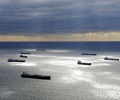Wrong-footed shippers could face lengthy HSFO shortages

The marine fuel market has been flipped on its head this year, with fears there would be a lack of IMO-compliant premium bunker fuels as shippers rushed to meet the new rules on sulfur content not materializing — instead shortages of its sulfurous cousin have emerged.
Outside of major hubs like Singapore, Fujairah and the key European ports, shipowners that fitted scrubbers — exhaust gas cleaning systems — so they could still burn the 3.5% sulfur bunker fuel face planning headaches for some time to come.
The imbalance is not a result of heavy demand from scrubber-fitted ships either, although that has certainly added to the overall picture. Instead, refiners changed their slates to meet the expected demand for very low sulfur fuel oil as shippers rushed to meet International Maritime Organization’s sulfur cap rule on January 1, 2020, and cut HSFO supply. At the same time, high sulfur residuals found new outlets as coker and petcoke feedstocks, notably on the US Gulf Coast, which has restricted the amount of product reaching the bunker pool.
“Current HSFO availability and pricing have clearly proved many forecasts wrong… with certain regions and ports currently not offering HSFO, owners and operators of scrubber tonnage may experience difficulty procuring HSFO,” marine fuels management company Integr8 said in a research note.
In particular, the number of ports supplying HSFO globally has halved in the three months between December and February, with South America, West Africa, the Black Sea, India, Australia and New Zealand as regions with little or no HSFO availability, according to Integr8.
It added that even in the major hubs, the number of suppliers offering HSFO has decreased sharply, with availability often thin.
LONG-HAUL
At present, an imbalance in supply and demand dynamics in the marine industry complicates the outlook further. Integr8 said that many suppliers prefer not to stock HSFO now because the ships fitted with scrubbers tend to be larger ones, which make fewer journeys but with larger volumes.
In addition, “scrubber vessel operations are spread globally and, while a share of HSFO demand is linked to term contracts, the majority of scrubber vessels procure bunker fuel on the spot market,” Integr8 said.
One bunker supplier in the Mediterranean reiterated this, saying that the majority of HSFO demand they saw was on the spot market as opposed to contracts.
However, reliance on spot availability does not match well with its reduced supply, with some market sources saying that spot volumes cannot be relied upon and should be sought ahead of time to secure availability.
One bunker supplier in Northwest Europe commented on the difficulty getting hold of HSFO, which resulted in a wide range of prices on the spot market. The bunker supplier added, however, that most of the demand they saw was contractual.
Looking further ahead, while demand for HSFO remains a relatively small proportion of overall bunker demand, analysts expect demand to rise in line with more scrubber installations, straining availability further.
Platts Analytics estimates there were 2,577 scrubber systems installed on vessels as of late March, consuming about 618,000 b/d of HSFO. It notes that while the coronavirus is causing an impact to labor availability for installations at shipyards, scrubber installations are expected to rise by a third by the end 2020, raising demand for HSFO fuel by a similar amount.
“Assuming most of the remaining [scrubber] order book is put into service… it will likely still not be enough to change the position of HSFO in the global bunker market so the expectation is for continuing difficulties with sourcing HSFO, at least in the near future,” Integr8 said.
SCRUBBER TEST
Owners that made the decision to invest in scrubbers have, it seems, had a relatively tough time, with the tightness in the market squeezing the economics of running HSFO.
The spread between delivered HSFO and VLSFO at Rotterdam was just $66/mt on Tuesday, having started the year at $296/mt, according to S&P Global Platts assessments.
However, many believe interest in scrubbers has and will remain resilient. Wartsila’s director of exhaust gas cleaning systems Sigurd Jenssen said in an interview with S&P Global Platts that its customers say an HSFO-VLSFO spread “somewhere between $50-$100/mt” means “scrubbers are still attractive.”
The energy equipment maker said it believes scrubbers will play an important role. “Longer term, the market will normalize and the financial logic doesn’t disappear. The savings are still there,” Jenssen added.
Source: Platts

 Hellenic Shipping News Worldwide Hellenic Shipping News Worldwide, Online Daily Newspaper on Hellenic and International Shipping
Hellenic Shipping News Worldwide Hellenic Shipping News Worldwide, Online Daily Newspaper on Hellenic and International Shipping





















 PG-Software
PG-Software